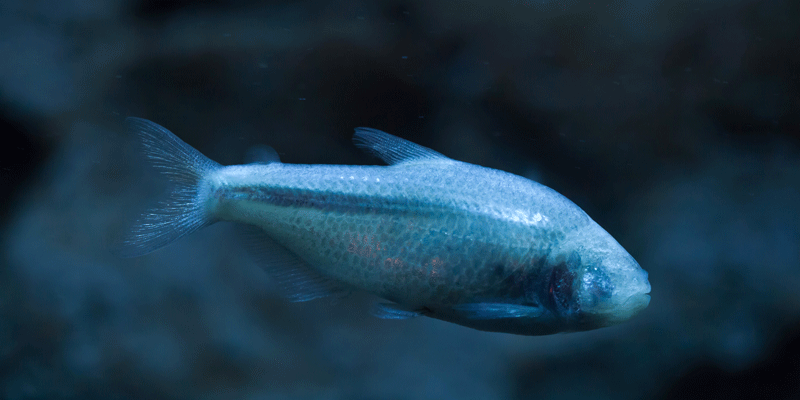Two new NSF grants allow Suzanne McGaugh and colleagues to gain more insight into how cavefish can alter behavior given changing conditions.

Antisocial blind cavefish are drastically different from their social surface-dwelling counterparts. Despite distinct appearances and lifestyles, the fish are members of the same species.
Evolutionary biologists have long been fascinated by this species. Suzanne McGaugh, assistant professor in Ecology, Evolution and Behavior, is interested in how organisms adapt behaviors in changing conditions. Organisms that can change their behavior in response to changing conditions have a leg up in the battle for resources and survival. This ability — known as plasticity — is important for survival and successful reproduction, yet scientists know very little about how it evolved or its genetic basis.
Mexican tetra make an excellent study system. With two new National Science Foundation (NSF) grants, McGaugh’s lab and her colleagues are working to better understand how the fish adapt to cave conditions and how flexible some traits are. With this knowledge, researchers plan to develop a suite of tools they can use to modify genes of the fish.
Sleeping and eating patterns of Mexican tetra specifically interest the researchers who co-wrote one grant. Joanna Kowalko, assistant professor at Florida Atlantic University and lead researcher on the grant, and Nick Rohner, assistant investigator at Stowers Institute, paired up with McGaugh.
“We think that cavefish are well adapted to pack on the weight in the really wet season and sleep less to do so. Then to withstand long periods without very much food, they sleep a lot more,” says McGaugh.
Surface fish are accustomed to constant food availability. When surface fish are held in captivity and food is limited, they spend less time sleeping and more time foraging. Exactly the opposite response of their cave-dwelling counterparts.
“There’s a plasticity that’s built into that. How often the fish sleep depends on where they live — in a cave or at the surface — and how much food is available. With this grant, we’ll be able to explore the plasticity of sleep in the two groups with different amounts of food availability,” says McGaugh.
Gaining a better insight into the genetic basis of cavefish’s behaviors has important health implications. About two years ago, the McGaugh lab in collaboration with the Yoshizawa lab in Hawaii published a study demonstrating that cavefish share behaviors to autistic patients. The differences between surface fish and cave fish was similar to normative to autistic individuals. “If you treat cavefish with one of the more common drugs to treat autistic patients, they will start to exhibit surface-fish characteristics. The fish sleep more, are less hyperactive and less focused on stimuluses,” says McGaugh.
Understanding linkages between the genome and the distinctive behaviors of cavefish could provide insight into a genetic basis of autism.
The other NSF grant will allow McGaugh and colleagues to decipher the connection of genes to traits. This will bring the species closer to being a model organism for biologists, like zebrafish or fruit flies.
—Claire Wilson